

Tandfonline. Design Matters: Development and Validation of the Online Course Design Elements (OCDE) Instrument. Allen, I.

E., & Seaman, J. (2017). Digital learning compass: Distance education enrollment report 2017. Anderson, K. (2017). Have we reached an inflection point in online collaboration? From e-mail to social networks, online collaboration has evolved fast—as have users. Baldwin, S., Ching, Y-H., & Hsu, Y-C. (2018). Blackboard. (2012). Bozarth, J., Chapman, D. Browne, M. California Community Colleges Online Education Initiative. (2016). California State University. (2015). Castle, S. Chen, S. Czerkawski, B. Dell, C. Dick, W. (1996). Dietz-Uhler, B., Fisher, A., & Han, A. (2007). Fathema, N., Shannon, D., & Ross, M. (2015). Gaytan, J., & McEwen, B. Graf, S., Liu, T. Han, I., & Shin, W. Illinois Online Network. (2015). Jaggars, S. Jones, K. Kline, R. Ko, S., & Rossen, S. (2017). Kumar, S., Martin, F., Budhrani, K., & Ritzhaupt, A. (2019).
Le Maistre, C. (1998). Li, C. Little, R. Liu, X., Magjuka, R. Baseline to Baseline+ – UCEM Online Education. Reflecting on my first experience of working on a UCEM Baseline+ module.
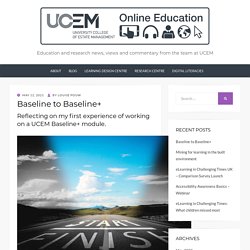
I have now been working as a Learning Designer for just over a year. I have very much enjoyed the opportunity to work on a wide variety of modules with academics and the rest of the Online Education team. Baseline modules. Educationalist. Guest post by Kate Mitchell, University of Melbourne A key part of my role as a learning designer (LD) in Higher Education involves helping faculty/teaching staff to redesign their courses for blended or online modes of delivery while also improving course quality.
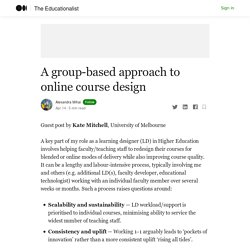
It can be a lengthy and labour-intensive process, typically involving me and others (e.g. additional LD(s), faculty developer, educational technologist) working with an individual faculty member over several weeks or months. Such a process raises questions around: Scalability and sustainability — LD workload/support is prioritised to individual courses, minimising ability to service the widest number of teaching staff.Consistency and uplift — Working 1–1 arguably leads to ‘pockets of innovation’ rather than a more consistent uplift ‘rising all tides’.
Last year, I was able to work as part of an LD team to support a team of teaching staff across courses from a single discipline in a group-based approach. The approach Scalability. 10. Moodle. Online learning is the future of teaching.

This three-week teaching course aims to support teachers’ own innovations in teaching and learning online, whether you teach in a school, college or university. See what’s possible with digital technologies and online learning methods. Designing for learning in the Yellow House: a comparison of instructional and learning design origins and practices: Higher Education Research & Development: Vol 39, No 5.
For the past two decades, there has been persistent debate around whether there is a difference between the fields of instructional design (ID) and learning design (LD).

While differences in the two approaches are certainly apparent, there are cross-over points that can provide ID and LD researchers and practitioners with opportunities for dialogue about the purposes and remit of research-based practices for optimal design. Though potentially disruptive, initiating dialogues among learning and instructional designers could lead to more thorough and critical analyses of both ID and LD repertoires. Should boundary crossings occur, there is a potential for a third space for the contemplation, research, and practice of design. Educationalist. Future Learning Design Podcast on Apple Podcasts. Learning theories timeline: key ideas from educational psychology. This interactive learning theories timeline highlights 50 key ideas or research papers related to nine key theories which can inform the design of blended and online learning in Higher Education.
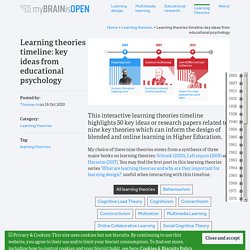
My choice of these nine theories stems from a synthesis of three major books on learning theories: Schunk (2020), Lefrançois (2019) and Harasim (2017). You may find the first post in this learning theories series ‘What are learning theories and why are they important for learning design?’ Twitter. 10. Rapid ABC for hybrid teaching. Support to enable a move to hybrid education.
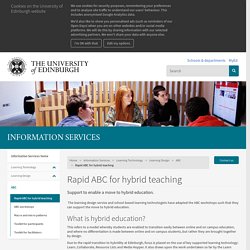
The learning design service and school-based learning technologists have adapted the ABC workshops such that they can support the move to hybrid education. What is hybrid education? This refers to a model whereby students are enabled to transition easily between online and on campus education, and where no differentiation is made between online and on campus students, but rather they are brought together by design. Due to the rapid transition to hybridity at Edinburgh, focus is placed on the use of key supported learning technology: Learn, Collaborate, Resource Lists and Media Hopper.
It also draws upon the work undertaken so far by the Learn Foundations project; this has focussed on improving the student experience in Learn through increasing consistency in the design of the online environment. Why ABC? What are the options? Those undertaking course (re)development can choose either: Macro patterns Micro patterns Related links Why ABC? Macro patterns. ABC Online Resources. Home ABC Learning Design ABC Online Resources ABC Online Resources Digital Media Participant Guide.
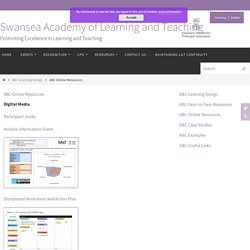
Designing for learning in the Yellow House: a comparison of instructional and learning design origins and practices: Higher Education Research & Development: Vol 0, No 0. For the past two decades, there has been persistent debate around whether there is a difference between the fields of instructional design (ID) and learning design (LD).
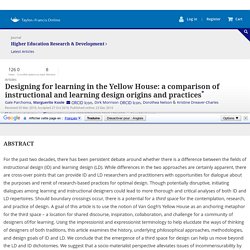
While differences in the two approaches are certainly apparent, there are cross-over points that can provide ID and LD researchers and practitioners with opportunities for dialogue about the purposes and remit of research-based practices for optimal design. Though potentially disruptive, initiating dialogues among learning and instructional designers could lead to more thorough and critical analyses of both ID and LD repertoires. Should boundary crossings occur, there is a potential for a third space for the contemplation, research, and practice of design. A goal of this article is to use the notion of Van Gogh’s Yellow House as an anchoring metaphor for the third space – a location for shared discourse, inspiration, collaboration, and challenge for a community of designers of/for learning.
Evidence-Informed Learning Design. International Learning Design Cross-Institutional Network (LD-CIN) - 12. Open University Dec 2019. 10:00 – 10:15 Welcome and introduction to the day (Gerald Evans) Survey (Mentimeter) – what are you hoping to get out of today?
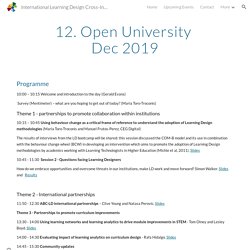
(Maria Toro-Troconis) Map My Programme. Please note this site is now archived and following a change from Google, motion charts are no longer supported. If you wish to discuss alternatives, please contact Simon Walker (s.walker@gre.ac.uk) or Mark Kerrigan (Mark.Kerrigan@anglia.ac.uk). When planning a programme it is important to consider how staff and students experience the delivery of that programme and its assessment. Assessment and Feedback - Teaching. Carroll, J. 2nd edn, (2007) A Handbook for Deterring Plagiarism in Higher Education [61], Oxford: Oxford Centre for Staff and Learning Development.
Handbook advocating a holistic approach to deterring plagiarism: institutional policies on and definitions of plagiarism, consistent approaches to cases of academic misconduct and information for students are covered along with course design to deter plagiarism and the role of assessment. Skills teaching is explored (induction vs apprenticeship) and there is a good deal of information on handling cases of plagiarism and associated penalties. A very useful guide for staff at all levels. The handbook can be ordered online [62] from Oxford Brookes University. Carroll, J. & Appleton, J. (2001) Plagiarism: A Good Practice Guide [63], JISC, available online at: [64]. 02671522.2019.
This paper elaborates on the notion of object-oriented collaborative learning by building on empirical material from two case studies in higher education. Prior empirical findings show how knowledge objects are evolving entities, shaped by the interactions between participants, and how students learn from engaging in knowledge practice that involves different activities with knowledge objects. However, the pedagogy of teaching and learning with objects needs to be further explored and grounded in empirical data. A thread compiling #LearningDesign #frameworks, #toolkits and other delights in #HigherEducation - please add to… Resources & Media – Ciel Associates. Paul Kleiman: All publications (PDF) Paul Kleiman ALL PUBLICATIONS (Jan 2018) Selected Articles PAUL KLEIMAN (2017) “We Don’t Need Those Learning Outcomes”: assessing creativity and creative assessment.
Case Study 2 in Elkington, S. & Evans, C. "The process of designing for learning: understanding university teache" by Sue Bennett, Shirley Agostinho et al. Abstract Interest in how to support the design work of university teachers has led to research and development initiatives that include technology-based design-support tools, online repositories, and technical specifications. Despite these initiatives, remarkably little is known about the design work that university teachers actually do. This paper presents findings from a qualitative study that investigated the design processes of 30 teachers from 16 Australian universities.
The results show design as a top-down iterative process, beginning with a broad framework to which detail is added through cycles of elaboration. 3776 14104 1 PB. A thread compiling #LearningDesign #frameworks, #toolkits and other delights in #HigherEducation - please add to… Resources & Media – Ciel Associates. Navigating Paradigms in Educational Technology. Document. Learning design – the long haul of institutional change. 2018 review of online learning: open pedagogy. Er.educause. Both edtechs and instructional designers (IDs) work with computer systems and programs, yet their actual duties differ from traditional IT tasks. The resulting confusion over what edtechs and IDs do—and how the two roles differ—is rampant, not least in the sector that needs them most: higher education. In a recent conversation with an assistant vice president (AVP) who manages both educational technologists (edtechs) and instructional designers (IDs), the AVP expressed confusion over the difference between the two roles.
In higher education, both roles typically report to the IT department. The confusion, then, should not be surprising. Neither role falls under traditional IT programming, systems analysis, or security roles, and, while the two roles revolve around computer systems and programs, their work is very different from traditional IT tasks. It isn't just IT folks who are confused. Another said: Example Scenarios Scenario 1 Scenario 2 ID Role and Responsibilities Salaries Table 1.
DigicapCurriculumDevChecklist. DigicapCurriculumDevChecklist. About ELDeR. Contest - TIDE Research Group of Interactive and Distributed Technologies for Education. #Design4Learning: Designing for the Future of Higher Education. Vol 34, No 2 (2018) Lessons about learning design in online environments: CRADLE Seminar Series. TEL edvisors sur Twitter : "The webinar videos from last week are now up on our YouTube channel at Many thanks once again to @karinbarac and @meg_colasante for kicking of our year so well, with some insightful discussion of what we.
ILT - The University of Northampton. Lessons about learning design in online environments: Seminar – 17 April 2018. Learning Design or Design Alchemy? Introduction to Educational Design in Higher Education. The Future of Learning Design: Amazon.co.uk: Shirley Agostinho, Sue Bennett, Lori Lockyer, Barry Harper: Books. Around the World of Learning Design in 10 minutes Liz Masterman May ppt download. Learning Design and Curriculum Mapping. Designing learning and assessment in a digital age. Designing Learning: From Module Outline to Effective Teaching - Christopher Butcher, Clara Davies, Melissa Highton. Module Design in a Changing Era of Higher Education - Academic. Design Develop Implement. Social approaches to course design. PASS. A Starter Kit for Instructional Designers. The Learning Design Grid. Educational Innovation design kit. Teaching and Learning Innovation Park. THU: The Potential of Video Concept Cards(Uffe Frandsen)
L·E·A·R·N – Flipped Toolkit. Open University Learning Design. 9789811002595 c2. Deborah Millar by Deborah Millar on Prezi. Carpe Diem - Gilly Salmon. UCL Digital Education team blog. Research Paper, Networked Learning Conference 2016 - NLC2016, Lancaster University UK. UCL Digital Education team blog. Evidence of the month: "Scaling up" learning design. Using technology to improve curriculum design. Online Course Activity Inspiration Cards. Characteristics of Course Design Intensives. CDIs for DIT May 2015. CDIs DiT handouts. CDI Resources pack VU College of Business.
2014 CDI pack MBM v2. Curriculum_Design_November14.pdf. Design Develop Implement: a team based approach - teche. RADAR Toolkit: Resources for Assessment Design, Alignment and Review - Support for students and staff - University of Exeter. Connected Curriculum. The Design Studio / Viewpoints project. Manchester Metropolitan University. ABC (Arena Blended Connected) curriculum design. What Technology Does What: An #edtech Chart For Teachers. Design Thinking, Deconstructed. Storyboarding OOC. He curriculum agenda.
Learning Design. British Journal of Educational Technology - Volume 46, Issue 2 - Teacher-led Inquiry and Learning Design. Engaging academics in collegial online professional development during a course renewal process: Intent and reflection. International Learning Design Challenge: Summary. UCL E-Learning Environments team blog. 12 Changes Coming To The Future Of Learning. Oslo BI site on assessment and feedback. Reidsema ASEE paper Final 28April. ASEE UQ (Cut 1).mp4. Open University Learning Design Initiative. Awesome Graphic on 21st Century Pedagogy. Curriculum-directions-decisions-and-debate. Carpe Diem MOOC. Bower 2010. Linking online course design & implementation to Learning outcomes: A design experiment.